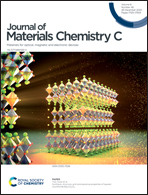Suppressing π–π stacking interactions for enhanced solid-state emission of flat aromatic molecules via edge functionalization with picket-fence-type groups†
Abstract
Polycyclic aromatic hydrocarbons (PAHs) are promising for materials science because of their high thermal and chemical stability, electron mobility, and unique photophysical properties. However, flat PAHs have limited applications owing to the low processability of their solutions, which originates from the strong π–π interaction between the aromatic rings. Herein, we report an effective method to suppress the π–π stacking of flat and large PAHs through steric hindrance. A 2,6-dimethylphenyl group, which is referred to as the “picket-fence” (PF) group based on its fence-like shape, was introduced on the edge of hexa-peri-hexabenzocoronene (HBC) through a bottom-up synthetic process. The PF group enhanced the solubility of HBC, while the unique photophysical properties of the core structure were preserved even in the solid state. The steric effect of the PF group is also demonstrated with other flat PAHs, which show excellent solid-state photophysical properties after functionalization with the PF group. Experimental and theoretical results indicate that the picket size plays a critical role in adjusting the PF effect. Furthermore, we fabricated the first organic light-emitting diode (OLED) that uses an HBC-based emitter, and the solid-state emission spectrum of the device is almost the same as that of the emitter in solution. This is possibly due to the maintenance of their morphology without aggregation due to the PF effect. Moreover, the full width at half maximum of the electroluminescence band was very narrow at only 20 nm.



 Please wait while we load your content...
Please wait while we load your content...